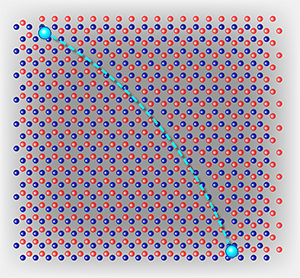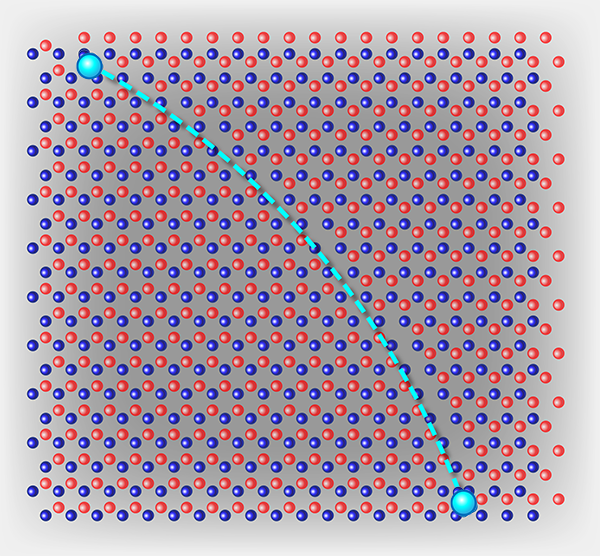Plastic Quantum Crystals
If you bend a piece of metal into a new shape, it will not spontaneously revert to the condition in which it started. The reason is that bending causes the metal to undergo a plastic deformation: an irreversible change of shape that occurs when an applied load exceeds a certain threshold. In Physical Review Letters, Ariel Haziot at the École Normale Supérieure in Paris, France, and colleagues report that the plastic properties of a “quantum solid,” helium-4, can be strikingly different: in helium-4, within a certain temperature range, large plastic deformations can still be reversible [1]. The findings highlight the unusual mechanical properties of quantum solids, and may serve as a model system for understanding the fundamental mechanisms contributing to plasticity.
Plasticity is the propensity of solids to “flow.” It is usually the result of the motion of dislocations, which are crystallographic defects in the form of lines of misfit between atomic planes. In a crystal with dislocations, a moderate shear can generate plastic flow by causing the dislocations to move. The effect is reminiscent of how the movement of a hump in a heavy carpet can be used to slide a carpet on a floor without having to move the whole carpet. Indeed, an ideal, defect-free classical crystal can’t flow, but only respond elastically to shear. This is why mechanical pieces that have to withstand tremendous stress, such as turbine blades, are now made of monocrystalline materials [2]—a possibility thanks to advances in crystal growth techniques, which can now avoid the presence of any dislocation. In the past, when single crystals could not be made free of dislocations, stiffness was restored through impurities, which act as pinning centers that lock dislocations in place, or by multiplying the number of dislocations so that they would pin each other.
Large plasticity thus relies on the presence of many dislocations that can easily move through the crystal. Not all crystal types, however, can accommodate a large number of dislocations. In a solid held together by covalent atomic bonds, dislocations can only move by breaking localized chemical bonds. Such materials are brittle, breaking easily. In contrast, the bonding in metals is not due to localized bonds, but to delocalized conduction electrons. Dislocations do not easily break metals and the ease of their motion explains why many metals are so malleable.
Delocalized bonds are also characteristic of other, more exotic types of solids: quantum crystals. These crystals are made up of atoms, like helium, or molecules, like hydrogen, that are so light that nuclear quantum effects become important, and new, nonclassical theories are needed to describe them. In quantum crystals, delocalization of bonds is the consequence of the lightness of atoms or molecules, which gives them, according to quantum mechanics, a large zero-point motion, i.e., a large excursion around their average position in the crystal. Since quantum crystals have highly mobile dislocations, their plasticity is often found to exceed that of normal materials.
Haziot et al. carried out a detailed study of the plasticity properties of solid helium-4, exploiting a novel experimental setup in which they can monitor the crystals, control their orientation, growth, and quality, and at the same time, measure their elastic moduli along different directions. Their results show that, in a certain temperature range, the crystal exhibits a giant plasticity that is reversible (the solid goes back to its original shape when the applied stress is released) and anisotropic (the solid flows with little resistance when shear is applied in a specific direction) [1].
Strictly speaking, what Haziot et al. observe is more of an elastic deformation than a conventional plastic one. In classical crystals, plasticity is, by definition, irreversible. However, Haziot et al. show that one of the elastic moduli of the crystal is dramatically reduced (by a factor of 3) compared to what is expected for a perfect crystal, and they carry out a number of tests to understand the origin of such behavior. The fact that, of the six different elastic moduli describing solid helium-4, only the shear modulus C44 is modified, and that the reduction in this modulus depends on the crystal growth and the number of helium-3 impurities, indicates that the effect is due to the motion of dislocations, like for plasticity.
The mechanisms underpinning such large plasticity can be explained in the following way. Solid helium-4 has a hexagonal crystal structure and it is known that in such structures dislocations slip easily in the so-called basal plane, which is perpendicular to the long axis ( c-axis) of the crystal. What prevents unlimited shear-induced flow along this plane are impurities, which pin the dislocations at various points (as illustrated in Fig. 1), or interactions between different dislocations. Under a shear stress, dislocations bend like strings between their pinning centers. The amplitude of their displacement is proportional to the applied stress, and gets larger when the distance between pinning centers is larger. This mechanism explains the anisotropy and why the effect is larger in higher quality crystals, which have fewer pinning centers and thus a larger average distance between them. Since no irreversible jumps from one pinning center to another are involved, but only elastic extension of the dislocations, the behavior is reversible. In helium-4, pinning centers could partly consist of impurities of helium-3, the lighter isotope of helium. Such impurities can diffuse in the crystal and condense on dislocations cores, where they find more room for their large zero-point motion, reducing their kinetic energy. Once condensed on a dislocation, they pin it, blocking its motion and restoring the standard elastic response. But above a certain threshold of applied stress, the dislocation can release itself from helium-3 impurities, which diffuse too slowly to follow it. This unpinning of dislocation lines is what leads to the large propensity to flow observed by the authors.
Such mechanisms are not the sole prerogative of quantum crystals. The modification of the elastic moduli due to the reversible motion of dislocations has indeed been seen in classical crystals [3], but it is so tiny that it only becomes measurable when dislocations resonate with one another, like strings, with the applied oscillating stress. The effect only occurs in a narrow frequency range and appears as a frequency-dependent damping mechanism for sound [3]. In quantum helium-4 crystals, however, the huge amplitude of the effect is due to the high quality of the crystals and to the absence of damping mechanisms for the motion of the dislocations sliding on the basal plane. Indeed, Haziot et al. show that, when the temperature is raised above 0.4K, damping by thermal phonons progressively suppresses the effect. As is often the case, the advantage of low-temperature measurement is the possibility to separate different mechanisms, like the motion of dislocations and their damping, which are intrinsically mixed in high-temperature classical systems.
The work of Haziot et al. is interesting at many levels. For physicists interested in the low-temperature properties of solids, it provides a precise and quantitative basis for interpreting the puzzling experimental results of Kim and Chan [4]. Kim and Chan observed that helium-4 solids are unexpectedly able to flow when rotated in a container at low temperature, which led to the controversial speculation that helium-4 could be a “supersolid,” a solid that flows with zero viscosity. Several experimentalists, including Chan himself, have now concluded that this interpretation was probably not correct (see 8 October 2012 Focus). Instead, alternative theories, such as the one proposed by Varoquaux [5] have attempted to explain such observations without invoking supersolidity. Such theories could be corroborated by Haziot et al.’s analysis. These findings are also a motivation for reexamining yet-to-be-understood results concerning the plasticity of other quantum crystals, such as the anomalous plasticity of hydrogen crystals reported recently [6]. Finally, the paper of Haziot et al. illustrates a remarkable example of how the study of quantum crystals unveils mechanisms that are hard to observe in more classical systems.
References
- A. Haziot, X. Rojas, A. D. Fefferman, J. R. Beamish, and S. Balibar, “Giant Plasticity of a Quantum Crystal,” Phys. Rev. Lett. 110, 035301 (2013)
- N. A. Protasova, “Some Features of Monocrystalline Turbine Blade Regeneration After High-Temperature Treatment,” Russian Aeronautics 55, 83 (2012)
- A. Granato and K. Lucke, “Theory of Mechanical Damping Due to Dislocations,” J. App. Phys. 27, 583 (1956)
- E. Kim, and M. H. W. Chan, “Probable Observation of a Supersolid Helium Phase,” Nature 427, 225 (2004)
- E. Varoquaux, “Dislocation Model of the Low-Temperature Elastic Anomalies of Solid Helium,” Phys. Rev. B 86, 064524 (2012)
- L. A. Alekseeva and I. N. Krupskii, “Low Temperature Plasticity of Pure Parahydrogen,” Phys. Solid State 49, 2104 (2007)





